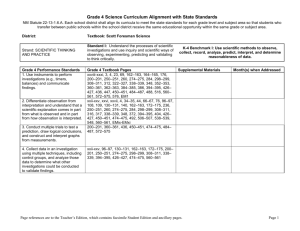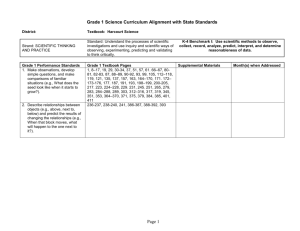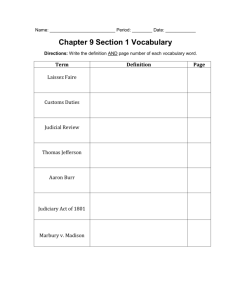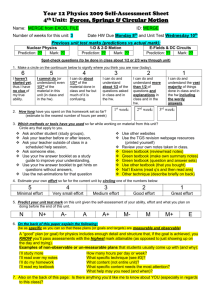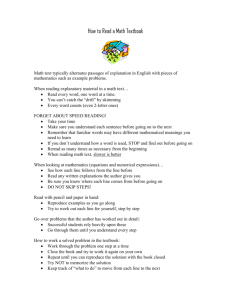Science, Grade 2
advertisement
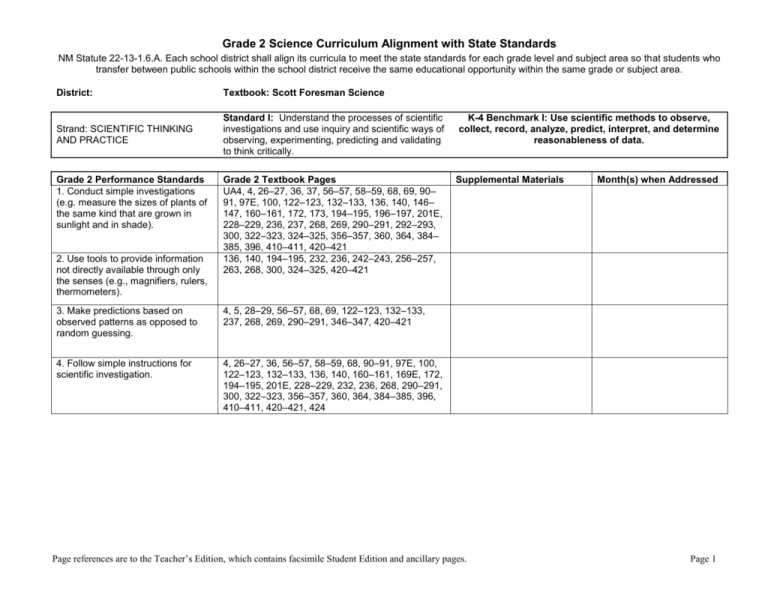
Grade 2 Science Curriculum Alignment with State Standards NM Statute 22-13-1.6.A. Each school district shall align its curricula to meet the state standards for each grade level and subject area so that students who transfer between public schools within the school district receive the same educational opportunity within the same grade or subject area. District: Textbook: Scott Foresman Science Strand: SCIENTIFIC THINKING AND PRACTICE Standard I: Understand the processes of scientific investigations and use inquiry and scientific ways of observing, experimenting, predicting and validating to think critically. Grade 2 Performance Standards 1. Conduct simple investigations (e.g. measure the sizes of plants of the same kind that are grown in sunlight and in shade). 2. Use tools to provide information not directly available through only the senses (e.g., magnifiers, rulers, thermometers). Grade 2 Textbook Pages UA4, 4, 26–27, 36, 37, 56–57, 58–59, 68, 69, 90– 91, 97E, 100, 122–123, 132–133, 136, 140, 146– 147, 160–161, 172, 173, 194–195, 196–197, 201E, 228–229, 236, 237, 268, 269, 290–291, 292–293, 300, 322–323, 324–325, 356–357, 360, 364, 384– 385, 396, 410–411, 420–421 136, 140, 194–195, 232, 236, 242–243, 256–257, 263, 268, 300, 324–325, 420–421 3. Make predictions based on observed patterns as opposed to random guessing. 4, 5, 28–29, 56–57, 68, 69, 122–123, 132–133, 237, 268, 269, 290–291, 346–347, 420–421 4. Follow simple instructions for scientific investigation. 4, 26–27, 36, 56–57, 58–59, 68, 90–91, 97E, 100, 122–123, 132–133, 136, 140, 160–161, 169E, 172, 194–195, 201E, 228–229, 232, 236, 268, 290–291, 300, 322–323, 356–357, 360, 364, 384–385, 396, 410–411, 420–421, 424 K-4 Benchmark I: Use scientific methods to observe, collect, record, analyze, predict, interpret, and determine reasonableness of data. Supplemental Materials Page references are to the Teacher’s Edition, which contains facsimile Student Edition and ancillary pages. Month(s) when Addressed Page 1 Grade 2 Science Curriculum Alignment with State Standards District: Textbook: Scott Foresman Science Strand: SCIENTIFIC THINKING AND PRACTICE Standard I: Understand the processes of scientific investigations and use inquiry and scientific ways of observing, experimenting, predicting and validating to think critically. . Grade 2 Performance Standards 1. Understand that in doing science it is often helpful to work with a team and share findings. Grade 2 Textbook Pages xxii-xxv, 32, 90–91, 168, 200, 228–229, 264, 328, 356–357, UD4, 410–411 2. Make accurate observations and communicate findings about investigations. xxii–xxv, 26–27, 28–29, 36, 56–57, 58–59, 90–91, 100, 122–123, 132–133, 136, 140, 160–161, 162– 163, 169E, 172, 173, 228–229, 236, 237, 263, 292– 293, 300, 322–323, 348–349, 356–357, 360, 364, 392, 396, 397, 410–411, 420–421, 424 Strand: SCIENTIFIC THINKING AND PRACTICE Grade 2 Performance Standards 1. Record observations on simple charts or diagrams. 2. Measure length, weight, and temperature with appropriate tools and express those measurements in accurate mathematical language. K-4 Benchmark II: Use scientific thinking and knowledge and communicate findings. Supplemental Materials Standard I: Understand the processes of scientific investigations and use inquiry and scientific ways of observing, experimenting, predicting and validating to think critically. . Grade 2 Textbook Pages 26–27, 56–57, 58–59, 132–133, 160–161, 194– 195, 220–221, 228–229, 258–259, 268, 292–293, 322–323, 346–347, 348–349, 356–357 92–93, 194–195, 220–221, 232, 242–243, 256– 257, 258–259, 292–293, 324–325, 420–421 Month(s) when Addressed K-4 Benchmark III: Use mathematical skills and vocabulary to analyze data, understand patterns and relationships, and communicate findings. Supplemental Materials Page references are to the Teacher’s Edition, which contains facsimile Student Edition and ancillary pages. Month(s) when Addressed Page 2 Grade 2 Science Curriculum Alignment with State Standards District: Strand: CONTENT OF SCIENCE Textbook: Scott Foresman Science Standard I (Physical Science): Understand the structure and properties of matter, the characteristics of energy, and the interactions between matter and energy. Grade 2 Performance Standards 1. Observe that properties of substances can change when they are mixed, cooled, or heated (e.g., salt dissolves in water, ice melts). Grade 2 Textbook Pages 232, 233, 234–235, 236, 237, 250–251, 252–255, 256–257 2. Describe the changes that occur when substances are heated or cooled and change from one state of matter to another (i.e., solid, liquid, and gas). 178–179, 244, 251, 252–255, 256–257 K-4 Benchmark I: Recognize that matter has different forms and properties. Supplemental Materials Page references are to the Teacher’s Edition, which contains facsimile Student Edition and ancillary pages. Month(s) when Addressed Page 3 Grade 2 Science Curriculum Alignment with State Standards District: Strand: CONTENT OF SCIENCE Textbook: Scott Foresman Science Standard I (Physical Science): Understand the structure and properties of matter, the characteristics of energy, and the interactions between matter and energy. Grade 2 Performance Standards 1. Describe how heat can be produced (e.g., burning, rubbing, mixing some substances). Grade 2 Textbook Pages 272–273, 278–281 2. Know that heat moves more rapidly in thermal conductors (e.g., metal pan) than in insulators (e.g., plastic handle 3. Describe the usefulness of some forms of energy (e.g., electricity, sunlight, wind, sound) and how energy (e.g., heat, light,) can affect common objects (e.g., sunlight warms dark objects, heat melts candles). 272–273, 278–281 4. Observe that sound is made by vibrating objects and describe it by its pitch and loudness. 329, 330–331, 332, 333, 334–337, 338–339, 341, 342–343, 344–345, 346–347, 348–349, 352 5. Recognize that moving objects carry energy (kinetic energy). 267, 270–272, 274–275, 286–287 K-4 Benchmark II: Know that energy is needed to get things done and that energy has different forms. Supplemental Materials Month(s) when Addressed 74, 80–81, UC1, UC2, UC4, 255, 262–263, 265E, 266–267, 268, 270–273, 274–275, 278–281, 284– 285, 286–289, 296, 331, 333, 334–335, 341, 368– 369, 374–375 Page references are to the Teacher’s Edition, which contains facsimile Student Edition and ancillary pages. Page 4 Grade 2 Science Curriculum Alignment with State Standards District: Textbook: Scott Foresman Science Strand: CONTENT OF SCIENCE Standard I (Physical Science): Understand the structure and properties of matter, the characteristics of energy, and the interactions between matter and energy. Grade 2 Performance Standards 1. Describe how the strength of a push or pull affects the change in an object’s motion (e.g., how a big or small push affects how high a swing rises). Grade 2 Textbook Pages 298–299, 300, 302–307, 308–309, 310–313, 314– 315 2. Observe that electrically charged materials and magnets attract and repel each other, and observe their effects on other kinds of materials. 318–321, 322–323, 396 K-4 Benchmark III: Identify forces and describe the motion of objects. Supplemental Materials Page references are to the Teacher’s Edition, which contains facsimile Student Edition and ancillary pages. Month(s) when Addressed Page 5 Grade 2 Science Curriculum Alignment with State Standards District: Textbook: Scott Foresman Science Strand: CONTENT OF SCIENCE Standard II (Life Science): Understand the properties, structures, and processes of living things and the interdependence of living things and their environments. Grade 2 Performance Standards 1. Observe that diversity exists among individuals within a population. Grade 2 Textbook Pages UA2, 112–113, 116–117, 118–121, UC3 2. Observe and describe various shapes of fungi. This standard is covered in Grades 4 and 5 3. Know that bacteria and viruses are germs. This standard is covered in Grade 3 Strand: CONTENT OF SCIENCE Standard II (Life Science): Understand the properties, structures, and processes of living things and the interdependence of living things and their environments. Grade 2 Performance Standards 1. Explain that stages of the life cycle are different for different animals (e.g., mouse, cat, horse, butterfly, frog). Grade 2 Textbook Pages UA1, 50–51, 98–99, 102–107, 108–109, 110–111, 122–123, 124–125, 128 2. Observe that many characteristics of the offspring of living organisms (e.g., plants or animals) are inherited from their parents. UA3, 106–107, 108–109, 110–111, 112–113, 114– 115, 116–117, 118–121 3. Observe how the environment influences some characteristics of living things (e.g., amount of sunlight required for plant growth). 2–3, 4, 6–7, 16–19, 20–21, 22–23, 24–25, 26–27, 38–41, 42–43, 44–45, 46–47, 48–49, 50–51, 52– 55, 67, 68, 114–115, 132–133, 360, UD4, 368 K-4 Benchmark I: Know that living things have diverse forms, structures, functions, and habitats. Supplemental Materials Month(s) when Addressed K-4 Benchmark II: Know that living things have similarities and differences and that living things change over time. Supplemental Materials Page references are to the Teacher’s Edition, which contains facsimile Student Edition and ancillary pages. Month(s) when Addressed Page 6 Grade 2 Science Curriculum Alignment with State Standards District: Textbook: Scott Foresman Science Strand: CONTENT OF SCIENCE Standard II (Life Science): Understand the properties, structures, and processes of living things and the interdependence of living things and their environments. Grade 2 Performance Standards 1. Identify a variety of human organs (e.g., lungs, heart, stomach, brain 2. Know that various nutrients are required for specific parts and functions of the body (e.g., milk for bones and teeth, protein for muscles, sugar for energy). Grade 2 Textbook Pages This objective is covered in Grades 4 and 5 3. Identify the functions of human systems (e.g., respiratory, circulatory, digestive). This objective is covered in Grades 4, 5, and 6 K-4 Benchmark III: Know the parts of the human body and their functions. Supplemental Materials Month(s) when Addressed This objective is covered in Grades 3 and 6 Page references are to the Teacher’s Edition, which contains facsimile Student Edition and ancillary pages. Page 7 Grade 2 Science Curriculum Alignment with State Standards District: Textbook: Scott Foresman Science Strand: CONTENT OF SCIENCE Standard III (Earth and Space Science): Understand the structure of Earth, the solar system, and the universe, the interconnections among them, and the processes and interactions of Earth’s systems. Grade 2 Performance Standards 1. Observe that the phase of the moon appears a little different every day but looks the same again after about four weeks. Grade 2 Textbook Pages 363, 380–381, 424 2. Observe that some objects in the night sky are brighter than others. . 3. Know that the sun is a star. 361E, 376–379, 380–381, 384–385, 392 K-4 Benchmark I: Know the structure of the solar system and the objects in the universe. Supplemental Materials Month(s) when Addressed 366–369, 376 Page references are to the Teacher’s Edition, which contains facsimile Student Edition and ancillary pages. Page 8 Grade 2 Science Curriculum Alignment with State Standards District: Textbook: Scott Foresman Science Strand: CONTENT OF SCIENCE Standard III (Earth and Space Science): Understand the structure of Earth, the solar system, and the universe, the interconnections among them, and the processes and interactions of Earth’s systems. Grade 2 Performance Standards 1. Know that rocks have different shapes and sizes (e.g., boulders, pebbles, sand) and that smaller rocks result from the breaking and weathering of larger rocks. 2. Understand that rocks are made of materials with distinct properties. Grade 2 Textbook Pages 146–147, 152–153, 228–229 3. Know that soil is made up of weathered rock and organic materials, and that soils differ in their capacity to support the growth of plants. xxii–xxv, 3, 22–23, 25, 138, 140, 141, 148–149, 152–153, 208–209, UD2 4. Recognize the characteristics of the seasons. UB2, 174–177, 180–181, 182–183, 184–185, 186– 187, 196–197, 230–231, 361E, 374–375 K-4 Benchmark II: Know the structure and formation of Earth and its atmosphere and the processes that shape them. Supplemental Materials Month(s) when Addressed UB3, 146–147, 152–153, 228–229 Page references are to the Teacher’s Edition, which contains facsimile Student Edition and ancillary pages. Page 9 Grade 2 Science Curriculum Alignment with State Standards District: Textbook: Scott Foresman Science Strand: SCIENCE AND SOCIETY Standard I: Understand how scientific discoveries, inventions, practices, and knowledge influence, and are influenced by, individuals and societies. Grade 2 Performance Standards 1. Describe ways to prevent the spread of germs (e.g., soap, bleach, cooking). Grade 2 Textbook Pages This objective is covered in Grade 3 2. Know that science has ways to help living things avoid sickness or recover from sickness (e.g., vaccinations, medicine) and adult supervision is needed to administer them. 394–395, 402–403 3. Know that some materials are better than others for making particular things (e.g., paper, cardboard, plastic, metal, fiberglass, wood). 150–151, 408–409, 410–411 4. Understand that everybody can do science, invent things, and formulate ideas. 32, 128, 132–133, 136, 200, 224, 228–229, 232, 264, 328, 356–357, 360, UD3, 391, 392, 416, 420– 421 This objective also can be fulfilled as students do science in the inquiries throughout Scott Foresman Science. Here are some of the many inquiry pages: 26–27, 56–57, 68, 90–91, 100, 122– 123, 132–133, 146–147, 194–195, 268, 290–291, 300, 322–323, 396, 410–411 UB1, UB4, 188–193, 200, 206–209, 210–211, 212– 215, 216–217, 352, 394, 398–401, 402–403, 404– 405, 406–407 5. Know that science has discovered many things about objects, events, and nature and that there are many more questions to be answered. K-4 Benchmark I: Describe how science influences decisions made by individuals and societies. Supplemental Materials Page references are to the Teacher’s Edition, which contains facsimile Student Edition and ancillary pages. Month(s) when Addressed Page 10
